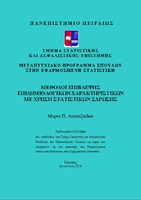Μέθοδοι επίβλεψης επιδημιολογικών χαρακτηριστικών με χρήση στατιστικών σάρωσης
Surveillance methods of epidemiological characteristics using scan statistics

View/
Subject
Multiple sclerosis -- Statistics ; Spatio-temporal analysis ; Communicable diseases -- EpidemiologyAbstract
Multiple sclerosis, also known as disseminated sclerosis or encephalomyelitis disseminata, is an inflammatory disease in which the insulating covers of nerve cells in the brain and spinal cord are damaged. This damage affects the ability of parts of the nervous system to communicate, resulting in a wide range of signs and symptoms. Despite the fact that the cause is not clear yet, the underlying mechanism is thought to be either destruction by the immune system or the inability of the cells to produce myelin. Until nowadays there is not any known cure for multiple sclerosis. Treatments attempt to improve function after an attack and prevent new attacks. Data analysis of Observations that are distributed in space or even in time, can be obtained using various scan statistics, either in one or two dimensional cases. This study presents in brief some ideas related to the one dimensional case, while its main aim is the investigation of two dimensional problems. In particular, spatial scan statistics introduced by Kulldorff (1997) have been employed, using a Poisson model. Data have been derived from 179 cases of patients which are hospitalized in three major geographic departments of Greece: Sterea Ellada, Epirus and Peloponnesus. By considering the home address of each patient and using the statistical program Sat Scan, we test the hypothesis of a random distribution of cases appearing in space, versus the hypothesis of spatial clustering which could imply location dependence. Due to the complexity of the problem, the present study focuses only in the presence of events in space, without taking into consideration factors such as gender, age etc. However, a further research would be judged necessary.

